A supercapacitor is a new type of energy storage component whose performance is between an electrolytic capacitor and a rechargeable battery. Supercapacitors have the advantages of high power density, fast charge and discharge rate, long cycle life and environmental friendliness. They are widely used in military, aerospace, solar photovoltaic power supply systems, camera phones, digital cameras and other fields.
Supercapacitor structure and working principle
A supercapacitor is a kind of two-end element, which can be divided into two types according to the structure.
The supercapacitor is similar in structure to the rechargeable battery, and is also composed of an electrode, a diaphragm, an electrolyte, a casing, and the like. Supercapacitors are divided into two types according to the electrode material and the energy storage mechanism: one is an electric double layer capacitor, which mainly uses an electric double layer at the interface between the electrode and the electrolyte for energy storage, and the electroactive material is mainly carbon-based; The species is involved in a rapid redox reaction to store energy, called a redox capacitor, with metal oxides and conductive polymers as electroactive materials. Carbon electrode supercapacitors are the earliest and the most mature technology; metal oxide supercapacitors rely on Faraday quasi-capacitor energy storage, and conductive polymer supercapacitors use P-type and N-type doping on conductive polymer electrodes to produce Faraday quasi-capacitors to store energy, this capacitor is still in the development stage.
The capacitance of an EDLC supercapacitor based on an electric double layer structure and using a porous carbon material as an electrode can be achieved in thousands of ways, and is structurally very similar to an electrolytic capacitor. The main difference between them is the electrode material, as shown in the following figure.
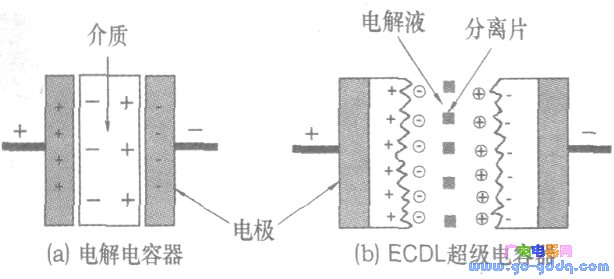
The working principle of supercapacitors is very different from traditional rechargeable batteries and electrostatic capacitors. The storage and release of energy from nickel and lead-acid batteries and lithium batteries are all related to chemical reactions, and supercapacitors have jumped beyond the scope of chemical reactions. It overcomes the shortcomings of the short life of traditional batteries (batteries) and the pollution to the environment.
The main features and advantages of supercapacitors
Supercapacitors are not based on the principle of traditional battery chemical reaction, but rely on the electric double layer principle or the Faraday quasi-capacitor principle to store energy, so they have the dual characteristics of electrolytic capacitors and rechargeable batteries. Supercapacitors have higher energy density and power density than electrolytic capacitors, and the ability to store charge is greater than that of conventional capacitors. The supercapacitor has very low impedance, fast charge and discharge speed, high efficiency, long cycle life, wide temperature range, good safety, and no pollution to the environment.
The energy density and power density of rechargeable batteries and electrolytic capacitors and supercapacitors are expressed in terms of specific energy and specific power. The so-called specific energy refers to the ratio of mass to mass; the unit is Wh/kg; the so-called specific power refers to the ratio of power to mass, and the unit is W/kg. The table below shows the performance comparison of EDLC supercapacitors with electrolytic capacitors and rechargeable batteries (nickel, lithium and lead-acid batteries).
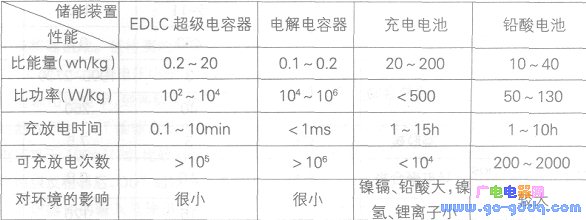
Supercapacitor development status
At present, in the technical level of supercapacitors, the United States, Japan, Europe, South Korea and other countries and regions are higher; in terms of industrialization, the United States Maxwell, ELNA, Japan NEC, Japan Electric, Matsushita, and Murakami, Russia's ELIT company, EMSA company, France SAFT company, South Korea Starcap company and other technologies are more advanced, occupying the majority of the super capacitor market. The table below shows the technical and industrial development of supercapacitors of major foreign companies.
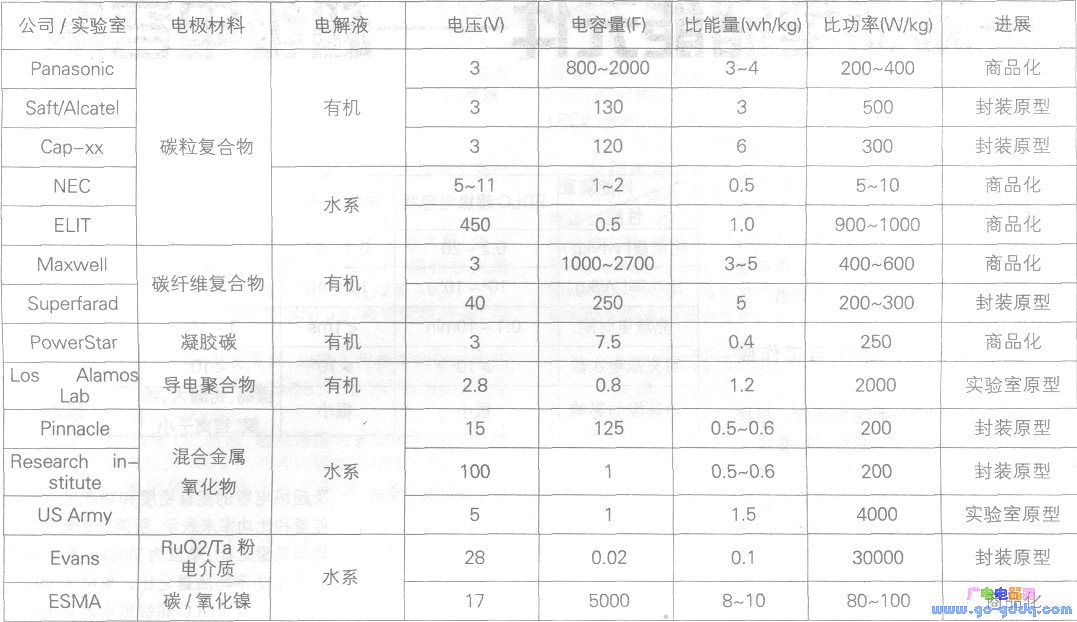
Supercapacitors have become a hot spot in many countries and regions. The recent goals set by the American Supercapacitor Symposium are: specific energy of 5Wh/kg, specific power of 500W/kg, cycle life of 100,000 times, and charge and discharge efficiency of 95%: the long-term goal is: energy density of 15Wh/kg, The power density is 1500 W/kg. In the "new sunshine plan" formulated by Japan, supercapacitors are listed as core projects. At the beginning of 1996, the European Union began to implement the supercapacitor R&D program, which was led by SAFT. The target is: mass ratio energy 6Wh/kg, volume ratio energy 8Wh/L, mass ratio power 1500W/kg, volume ratio power really 2000W/L, cycle The life span exceeds 100,000 times.
China's research work on supercapacitors started late and has become active in recent years. As early as the "10th Five-Year Plan" period, China has listed the major special projects for supercapacitors for electric vehicles in the "863" plan. At present, there are 811 schools of eight hospitals, the PLA Anti-Chemical Institute, the Beijing Nonferrous Metal Research Institute, Tsinghua University, Beijing Institute of Technology and other research institutes. Shanghai Aowei Company, Harbin Shirong Company, Beijing Jixing Company and Jinzhou Jinrong Company have already achieved initial industrialization in civil supercapacitors.
Ten years ago, supercapacitors were sold in small quantities and were expensive, about $1 to $2 per law. Nowadays, supercapacitors have been supplied to the market as a standard product in large quantities, and the price has been greatly reduced, only 0.01 to 0.02 US dollars / law.
Supercapacitor application
Supercapacitors fill the gap between components between electrolytic capacitors and rechargeable batteries. They have the advantages of high power and energy density, long cycle life, rapid charge and discharge, wide temperature range, safety and reliability. They are ideal for space and military applications. Used as a high-power energy storage power source in some new equipment and new concept weapons in the field. The specific applications of supercapacitors in new equipment and new concept weapons include various SAR series satellites, new launch vehicles, strategic missiles, high-energy laser weapons, electromagnetic orbital guns/electromagnetic coil guns, high-energy microwave weapons, active interference systems, and electromagnetics. Armor and so on. Supercapacitors also have broad and potential markets in the fields of consumer electronics, industry, and transportation.
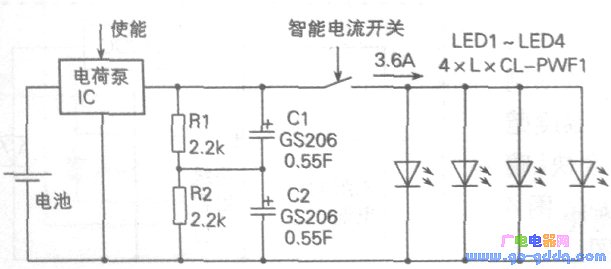
Supercapacitors can be used as energy storage components in camera phone LED flash circuits, as shown below. In the figure, the low-cost current-type charge pump charges the supercapacitors Cl and C2 to 5.5V, then activates the current switch and sends a large current pulse to flash the LED. The energy and power gained by the LED comes from the supercapacitor, not the battery and the charge pump. R1 and R2 are balance resistors, Cl and C2 are 0.55F, 50MΩ CAP=XXGS206, and LED is LMX-CL-PWF1 produced by lumileds. Its forward voltage drop is 3.75V (maximum 4.2V rated current is 900mA). The flash pulse duration is about 160ms, and the recharge time between flash shots is generally about 2s.
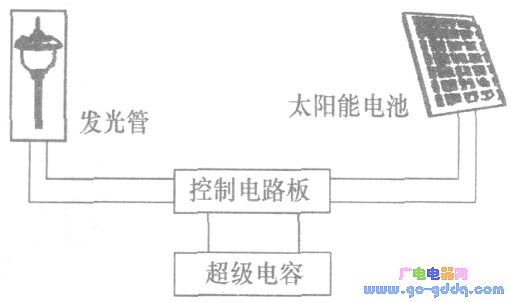
Supercapacitors can be used as batteries in solar luminaire systems, as shown in the figure above. Power storage with supercapacitors has almost no charge/discharge limit (>105 times), maintenance-free, no memory effect, wide temperature range (-40°C~-70°C), fast charging speed (think on sunny days, 8h on rainy days) And environmental protection and other advantages. Figure 4 shows a simplified circuit diagram of the supercapacitor. The solar LED lamp shown in Fig. 4 can be used as a street lamp, a decorative lamp, a lawn lamp, a garden lamp, an indicator lamp, and the like. If the minimum input voltage of the DC/DC boost converter in the circuit shown below is 1V, it is required to work for 8h, the LED current is 5mA, and the LED flashes (lights 1Ds dark 2s). The supercapacitor capacity should be 50F (2.75V); if the load is 2 LEDs in series, a 100F/2.75V supercapacitor should be selected. 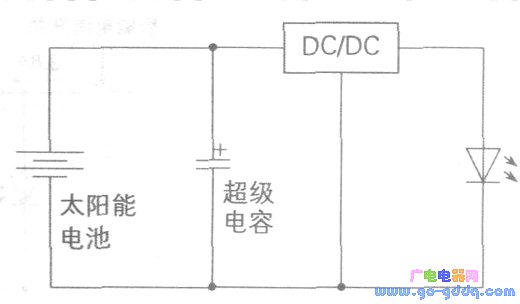
This website tries to open micro- and small-enterprise business advertising business; maintenance point recommended items. The fee is affordable and effective! Welcome to contact in QQ or email!
Why do you want to do online advertising contact?
- 0
- like
| Try to find the information you want to see. Inverter sensor patch three no weight loss camera LCD monitor does not boot digital camera XC9237 projector switching power supply laptop processor IPSUSB skills entrepreneurial black screen water heater can not boot circuit design silent transformer XC6102 without sound XC6112 display regulator no image microwave player successful silent GPS tea no picture XC6222 health XC6372 relay filter ML6209 switch washing machine digital camera description remote control without grating 555 protection circuit cancer self-closing Linux charger mobile phone shutdown noise inverter oscilloscope robot Windows antenna indicator light is not bright fiber life transformer stomach market alarm Hard disk watch embedded system woman maintenance process memory XC9236 converter router interview server kidney RFIDLED driver Konka CDMA instrument Panasonic CCD flashing engine multimeter Apple liver motor resistance keyboard integrated circuit current transformer triode governor power supply LED |
0.8mm Pin Header
Antenk 0.8mm Pitch Male Header series is a fine pitch, low profile, single/dual/three/four row, PCB mounted connector set intended for limited space applications or where total weight is a factor. Our specially tooled insulators and contacts maintain consistent high quality through our automated production processes. Each series is available in thru-hole PCB or SMT mounting and plated tin, gold or selective gold as specified.
0.8mm Pin Header Options
Number of Rows
1/Single
2/Double
3/Three
4/Quad
Number of Positions
2 Position
3 Position
4 Position
5 Position
6 Position
8 Position
10 Position
12 Position
14 Position
15 Position
16 Position
17 Position
20 Position
Termination Style
SMD/SMT
Through Hole
Mounting Angle
Right Angle
Straight
0.8mm Pin Header Specifications:
Material: Standard Hi-Temp insulator: Nylon 6T, rated UL94V-0
Insulator Color: Black
Contacts: Phosphor Bronze
Plating:
U = Gold over nickel underplate
SG = Gold over nickel underplate on
contact area, tin over copper underplate on tails.
T = Tin over copper underplate overall.
Electrical:
Operating voltage: 250V AC max.
Current rating: 1 Amp max
Contact resistance: 20 mΩ max. initial
Insulation resistance: 5000 MΩ min.
Dielectric withstanding voltage: 1000V AC for 1 minute
Mechanical:
Mating durability: 500 cycles min.
Temperature Ratings: Operating temperature: -40°C to +105°C
Max process temp: 230°C for 30 ~ 60 seconds (260°C for 10 seconds)
Soldering process temperature: 260°C
Packaging:
Anti-ESD plastic bags or tubes
Approvals and Certifications:
UL Recognized File no. E224053
Pin Header,0.8Mm Male Header,0.8Mm Pin Header,0.8Mm Male Header Pins,0.8mm Pitch Pin Header,SMT 0.8mm Pin Header, THT 0.8mm Pin Header
ShenZhen Antenk Electronics Co,Ltd , https://www.antenkcon.com
